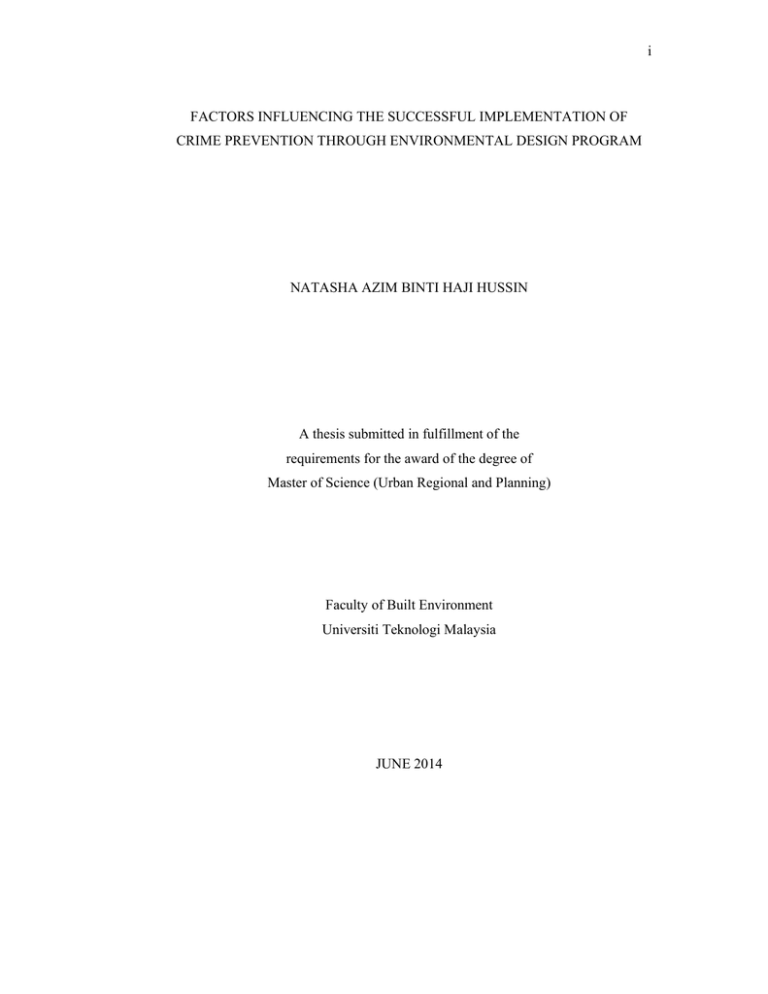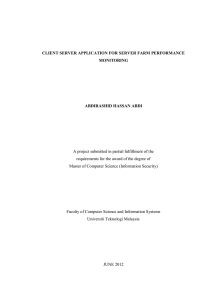i FACTORS INFLUENCING THE SUCCESSFUL IMPLEMENTATION OF
advertisement

i FACTORS INFLUENCING THE SUCCESSFUL IMPLEMENTATION OF CRIME PREVENTION THROUGH ENVIRONMENTAL DESIGN PROGRAM NATASHA AZIM BINTI HAJI HUSSIN A thesis submitted in fulfillment of the requirements for the award of the degree of Master of Science (Urban Regional and Planning) Faculty of Built Environment Universiti Teknologi Malaysia JUNE 2014 iii To my beloved husband Shahli Bin Mohammad Sanusi My beloved son Muhammad Rizqy Ramadhan My beloved daughter Mulya Raisha My beloved mothers Saudah Binti Ahmad and Sa’aunah Binti Nordin My beloved fathers Hussin Bin Ahmad and Mohamad Sanusi Bin Yunus & My beloved family members iv ACKNOWLEDGEMENT In preparing this thesis, I was in contact with many people, researchers, academicians, and practitioners. They have contributed towards to my understanding, insights and thoughts. In particular, I would like to express my sincere appreciation to my main thesis supervisor, Professor Dr. Shuhana Binti Shamsuddin, for her encouragement, guidance, criticisms, love and care. I am also very thankful to my Professor Dr. Ahmad Bashri Bin Sulaiman for his guidance, advice and motivation and to my Green Cities Research Group members for their continuous support and interest, this thesis would not have been the same as presented here. I am also indebted to Kuala Lumpur City Hall (KLCH) for funding my scholarship in this Master’s degree and Universiti Teknologi Malaysia (UTM) for funding my Research Grant in this field. This is also especially dedicated to my husband, Shahli Bin Mohamad Sanusi and my children Muhammad Rizqy Ramadhan and Mulya Raisha, for your understanding, support, love, care and especially your constant patience and sacrifices to ensure that this thesis is successfully completed and to my mothers and fathers who have always been by my side. A big appreciation goes to my family members for their endless encouragement and motivation. My sincere appreciation also extends to all my colleagues in KLCH, UTM, Nurul Shima Abd Rahman the professional proof reader for my thesis and Fiza Thalhan the professional translator for my abstract and others who have provided assistance at various occasions. Their views and tips are very useful and resourceful indeed. Last but not least, thank you for making this dream comes true. v ABSTRACT The rising crime rate in Kuala Lumpur, in line with the implementation of Crime Prevention Through Environmental Design (CPTED) starting from 2004 has sparked questions on the effectiveness of the implementation by the Kuala Lumpur City Hall (KLCH). CPTED is a manipulation of the built environment to prevent the occurrence of crime. It is an effective method to be implemented which is also a cost efficient method for long term period. This study aims to examine factors that will influence the successful implementation of CPTED, as well as to determine the awareness level of the implementers and the implementation level by the KLCH. The scope of this study focuses on the implementation of CPTED by the KLCH implementers who is involved in the developments of Kuala Lumpur. This study applies ‘mixed method’ methodology because of the research objective requires quantitative and qualitative data. Two techniques were used for this study; quantitative techniques using questionnaires and qualitative techniques using semistructured interviews with ‘content analysis’ method for relevant policy documents. Questionnaires were used to collect data from 321 respondents from ten technical departments and one non-technical department while semi-structured interviews were conducted with three officers from the Top Management Level. Respondents were selected using the ‘purposive sampling’ technique. Questions were designed to explore ten factors that have been formulated from the theoretical framework. Quantitative data and qualitative data were analysed using the interpretation technique. The quantitative data was described using the median value, percentage and frequency. The awareness and implementation level of CPTED by the KLCH was at a moderate level. This was affected by several factors, namely (1) lack of effective communication and five ancillary factors namely (2) lack of awareness, (3) lack of education and knowledgeable staffs, (4) lack of skilled and capable staffs, (5) lack of cooperation and (6) lack of effective monitoring systems. In conclusion, the successful implementation of CPTED by the KLCH can be enhanced by improving the factors identified within this research. vi ABSTRAK Peningkatan kadar jenayah di Kuala Lumpur yang sejajar dengan pelaksanaan Pencegahan Jenayah Melalui Reka Bentuk Alam Sekitar (CPTED) bermula dari tahun 2004 telah mencetuskan persoalan terhadap keberkesanan pelaksanaannya oleh Dewan Bandaraya Kuala Lumpur (DBKL). CPTED ialah kaedah memanipulasikan rekabentuk persekitaran alam bina bagi mencegah berlakunya jenayah. Ianya merupakan kaedah yang efektif dan menjimatkan kos untuk dilaksanakan bagi jangka masa panjang. Kajian ini bertujuan untuk mengkaji faktor-faktor yang akan mempengaruhi kejayaan pelaksanaan CPTED, menentukan tahap kesedaran kakitangan dan juga tahap pelaksanaan oleh DBKL. Skop kajian tertumpu kepada pelaksanaan CPTED oleh DBKL, khususnya kumpulan pelaksana yang terlibat dengan pembangunan di Kuala Lumpur sahaja. Kajian ini mengaplikasikan kaedah“mixed method” kerana objektif kajian yang memerlukan data dari jenis kuantitatif dan kualitatif. Dua teknik yang digunakan ialah teknik kuantitatif yang menggunakan borang soal selidik dan juga teknik kualitatif menggunakan kaedah temubual separa berstruktur serta kaedah “content analysis” ke atas dokumen polisi yang berkaitan. Borang soal selidik digunakan untuk menggumpulkan data bagi 321 responden dari 10 jabatan teknikal dan satu jabatan bukan teknikal manakala temubual separa berstruktur dijalankan ke atas tiga pegawai Peringkat Pengurusan Tertinggi. Pemilihan responden dibuat dengan menggunakan teknik “purposive sampling”. Soalan direkabentuk untuk meneroka 10 faktor yang telah dirumuskan daripada kerangka teoritikal. Data kuantitatif dan data kualitatif dianalisis dengan menggunakan teknik tafsiran. Data kuantitatif dihuraikan dengan menggunakan nilai median, peratusan dan kekerapan.Didapati bahawa tahap kesedaran dan tahap pelaksanaan CPTED oleh DBKL berada ditahap yang sederhana. Ianya disebabkan oleh beberapa faktor iaitu (1) kurangnya komunikasi yang berkesan dan lima faktor sampingan ialah (2) kurangnya kesedaran, (3) kekurangan kakitangan yang berpendidikan dan berpengetahuan, (4) kekurangan kakitangan yang berkemahiran dan berkeupayaan (5) kurang bekerjasama dan (6) sistem pemantauan yang kurang berkesan. Pada kesimpulannya kejayaan pelaksanaan CPTED oleh DBKL dapat dipertingkatkan dengan penambahbaikan ke atas faktor-faktor yang telah dinyatakan di dalam kajian ini.



